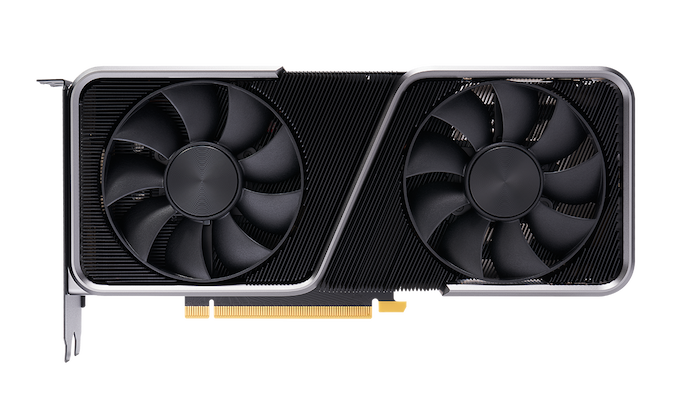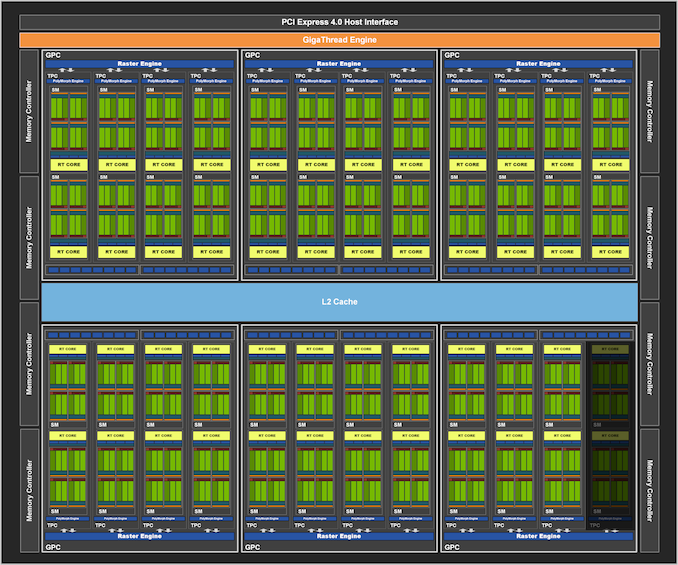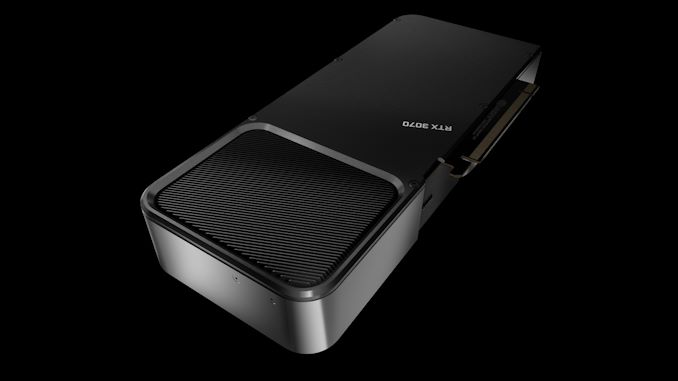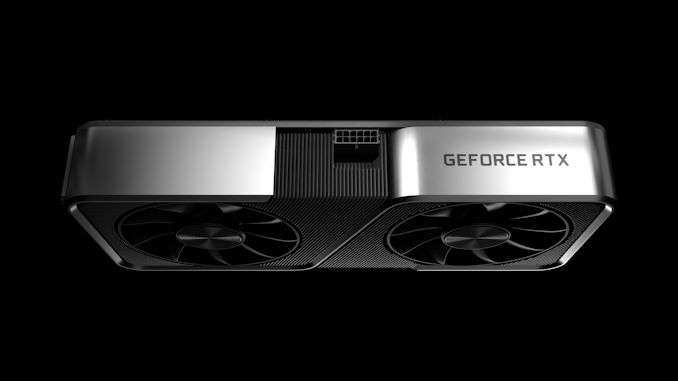Launching This Week: NVIDIA’s GeForce RTX 3070; 1440p Gaming For $499
by Ryan Smith on October 27, 2020 11:00 AM EST- Posted in
- GPUs
- GeForce
- NVIDIA
- GeForce RTX
- RTX 3070

It’s a couple of weeks later than originally planned, but this week NVIDIA is finally amping up the last of its high-end video card lineup with the release of the GeForce RTX 3070. Based on the Ampere architecture first launched back in September for the GeForce RTX 3080, the RTX 3070 is NVIDIA’s $500 take on a next-gen video card, incorporating a leaner Ampere GPU and otherwise shrinking Ampere down to something that’s a bit lighter on the wallet. Fittingly, whereas the RTX 3080 was positioned for 4K gaming, the RTX 3070 is being aimed at the 1440p crowd, a lower resolution that the Ampere card is very capable of handling. Reviews of NVIDIA’s Founders Edition (reference) card are going out today, with retail sales of NVIDIA and partner cards set to kick off on October 29th.
The latest in a long-line of xx70 video cards from NVIDIA’s well-calibrated product stack, the RTX 3070 is designed to fill a familiar and important role for NVIDIA, rounding out NVIDIA’s high-end product stack with a more value-orientated enthusiast offering. 70 cards are seldom as flashy as 80 cards – flashy costs money – but they’re typically the strongest value proposition among NVIDIA’s enthusiast cards. Though the price tag of $499 (and higher) is still a significant one overall.
The GeForce RTX 3070 was originally set to launch on October 15th. However following the rougher-than-expected launch for the RTX 3080, where the launch shipment of cards sold out quickly even by video card standards, NVIDIA held back the RTX 3070 launch by two weeks to have “more cards available on launch day” by building up an extra two weeks of stock. We’ll see how things go on Thursday, but as is virtually always the case, I’m still expecting these cards to sell out. This year more than any other, gaming is in – especially since you can’t go out.
Diving into the nuts and nuts and bolts of the RTX 3070, this card marks the debut of NVIDIA’s second Ampere GPU, GA104. Cut from the same cloth as the GA102 chip found in RTX 3080/3090, GA104 offers all of Ampere’s functionality and architecture changes, from the use of second-generation ray tracing cores and significantly revised SMs out to HDMI 2.1 output support, just at a smaller scale. Overall GA104 weighs in at 17.4 billion transistors, with a die size of 393mm2. And, like GA102 before it, the chip is being made on Samsung’s 8nm process.
This marks the second time in a row that NVIDIA has minted a separate GPU design for an xx70 card, instead of reusing the GPU used in xx80. For consumers the difference isn’t material to performance, but from a big-picture point of view is means that the 3070 isn’t made from salvaged GA102 dies. Given NVIDIA’s supply constraints with RTX 3080 (GA102) this should mean that they have an easier time keeping up with demand, since smaller dies yield better and NVIDIA gets more of them per wafer.
| NVIDIA GeForce Specification Comparison | ||||||
| RTX 3070 | RTX 3080 | RTX 2070 | GTX 1070 | |||
| CUDA Cores | 5888 | 8704 | 2304 | 1920 | ||
| ROPs | 96 | 96 | 64 | 64 | ||
| Boost Clock | 1.725GHz | 1.71GHz | 1.62GHz | 1683MHz | ||
| Memory Clock | 14Gbps GDDR6 | 19Gbps GDDR6X | 14Gbps GDDR6 | 8Gbps GDDR5 | ||
| Memory Bus Width | 256-bit | 320-bit | 256-bit | 256-bit | ||
| VRAM | 8GB | 10GB | 8GB | 8GB | ||
| Single Precision Perf. | 20.3 TFLOPs | 29.8 TFLOPs | 7.5 TFLOPs | 6.5 TFLOPs | ||
| Tensor Perf. (FP16) | 81.3 TFLOPs | 119 TFLOPs | 59.8 TFLOPs | N/A | ||
| Tensor Perf. (FP16-Sparse) | 163 TFLOPs | 238 TFLOPs | 59.8 TFLOPs | N/A | ||
| TDP | 220W | 320W | 175W | 150W | ||
| GPU | GA104 | GA102 | TU106 | GP104 | ||
| Transistor Count | 17.4B | 28B | 10.8B | 7.2B | ||
| Architecture | Ampere | Ampere | Turing | Pascal | ||
| Manufacturing Process | Samsung 8nm | Samsung 8nm | TSMC 12nm "FFN" | TSMC 16nm | ||
| Launch Date | 10/29/2020 |
09/17/2020 | 10/17/2018 | 06/10/2016 | ||
| Launch Price | MSRP: $499 | MSRP: $699 | MSRP: $499 Founders $599 |
MSRP: $379 Founders $449 |
||
In a full configuration, GA104 comes with 48 SMs. But for the purposes of making a yielding product with the RTX 3070, NVIDIA enables 46 of those SMs. This gives the card 5888 FP32 CUDA cores, a distinct step down from RTX 3080, but significantly more than the earlier 2070/1070 cards that RTX 3070 replaces. The card also comes with 96 ROPs, thanks once again to NVIDIA decoupling the ROPs from the memory controllers, which is another significant improvement from past cards and actually puts the RTX 3070 at parity with the RTX 3080. Speaking of parity, rated clockspeeds are also virtually identical to the RTX 3070, with an official boost clock of 1.725GHz.
By the numbers then, on paper the RTX 3070 offers 68% of RTX 3080’s shading/texturing/compute performance, but 101% of its pixel throughput performance. This is a fairly big spread, and unsurprisingly net result is something that meets in the middle of those figures – and to the RTX 3070’s favor. Otherwise, like the RTX 3080 before it, the RTX 3070 is a significant step up over the RTX 2070/2070S it replaces, offering a bigger generation-over-generation leap than the RTX 2070, though as far as upgrades go, NVIDIA’s target market for the card remains GTX 1070 and other Pascal card owners.
Along with the smaller GPU, another area where RTX 3070 dials things down relative to the RTX 3080 is with memory. Whereas NVIDIA’s Ampere gaming launch card shipped with 10GB of the new GDDR6X memory, RTX 3070 only comes with 8GB of GDDR6. The end result is that RTX 3070 gets 448GB/sec of memory bandwidth thanks to its 256-bit memory bus, which is around 58%. So it’s a not-insignificant drop there, and a big part of why RTX 3070 is focused on 1440p gaming even though it has 96 ROPs. NVIDIA isn’t feeding the beast nearly as heartily.
In fact I’m a bit surprised here that NVIDIA only went with 14Gbps GDDR6 for the card, given that 16Gbps GDDR6 is (theoretically) readily available. This is the same memory clockspeed that high-end GDDR6 RTX 20-series cards used, so the RTX 3070 doesn’t offer any more memory bandwidth than the RTX 2070(S). Ultimately memory bandwidth is just one factor driving a GPU’s performance, but I would have expected NVIDIA to at least use 16Gbps memory here to squeeze out a bit more performance from the card.
Otherwise, the use of GDDR6 instead of GDDR6X is unsurprising. GDDR6X is still new and only comes from a single manufacturer, so even if Micron can supply it in the volumes NVIDIA would want, GDDR6 is still going to be cheaper by virtue of a larger pool of suppliers. With that said, NVIDIA has confirmed that GA104 is capable of using GDDR6X as well, so while it’s not used today for the RTX 3070, you can easily envision NVIDIA offering an RTX 3070 Super down the line with 8 or 16 gigabytes of the faster memory; NVIDIA has left themselves a clear mid-generation upgrade path.
Moving on, let’s talk about power consumption. With a smaller GPU and slower memory, NVIDIA has been able to significantly dial down the TDP of the RTX 3070 compared to the joule-bingeing RTX 3080. The RTX 3070 has a TDP of 220W, 100W under the RTX 3080 and comparable to the likes of the last-generation RTX 2080. To be sure, NVIDIA is still paying for a good chunk of the card’s overall performance gains with increased power consumption – the RTX 2070 Founders Edition was a 185W card – but it’s more in line with historical norms for high-end NVIDIA cards.
This is notable not only because it opens the door to the RTX 3070 being more energy efficient than the RTX 3080, but because it means the RTX 3070 just flat-out plays more nicely in more systems. The card doesn’t need quite as powerful of a PSU to drive it, or a case that can dissipate 300W+ of video card heat on top of the CPU and other heat sources. So for prospective gamers who might have been worried about feeding (or cooling) that beast, the RTX 3070 is a better experience in both regards. In that respect, it’s a successor of sorts to the RTX 2080, occupying a virtually identical thermal design point.
And speaking of cooling, the RTX 3070 gets a variant on NVIDIA’s new “flow through” cooler. As with the RTX 3080, this means that NVIDIA has used a short PCB in order to leave the far side of the card open to directly push air through the unencumbered heatsink in order to improve cooling and reduce noise. However the lower-power, lower-heat RTX 3070 is a bit simpler overall, and more typical looking as well. Instead of a rear-mounted fan, RTX 3070’s flow through cooler puts both fans on the front, with the right fan pushing air through instead of pulling. The difference is not too significant on the mechanics of the cooler, but it underscores how RTX 3070 is a more conventionally-designed card than RTX 3080. Coupled with its 9.5-inch length, and it doesn’t look too far out of place from the RTX 2070.
Do note, however, that you’ll still need a 12-pin power connector to feed the card. As with the RTX 3080, NVIDIA is sticking with their new power connector standard here, and including a new 8-pin to 12-pin adapter to handle backwards compatibly. Curiously, this is not the same adapter that NVIDIA includes with the RTX 3080/3090 – that card gets a 2x8-pin to 12-pin adapter – and instead, owing to the fact that the RTX 3070 only needs 145W from an external power cable, this is a 1x8-pin to 12-pin adapter.
Consequently, we now have multiple types of 12-pin adapters floating around. And while I haven’t yet tried the new adapter with the RTX 3080, since this adapter only populates half of the pins on the 12-pin connector, I imagine that 1x8-to-12 adapters won’t lead to any real problems beyond finding out you have the wrong adapter in a drawer in 5 years’ time. In the meantime, needing to distribute adapters now is the price NVIDIA is willing to pay to ensure that at least their high-end RTX 30-series cards use a single, consistent power connector.
Power connector excitement aside, the rest of the I/O and ports remain unchanged from the RTX 3080. This means 3x DisplayPort 1.4 outputs, and 1x HDMI 2.1 port. Similarly, this means that the card can drive 4 displays overall.
Product Positioning & The Competition
As mentioned previously, NVIDIA is aiming the RTX 3070 at 1440p gaming. The card does have enough power to play with 4K in some games, especially as games have yet to catch up with the performance gains from NVIDIA’s new cards, but going forward that’s not expected to be the case. And anyhow, with only 8GB of VRAM, the RTX 3070 doesn’t have much to spare for even larger buffers.
For this week’s launch NVIDIA is once again selling its reference (Founders Edition) cards at retail. From a specifications standpoint these cards are identical to the baseline RTX 3070 specifications; NVIDIA previously stopped factory overclocking FE cards, and it hasn’t returned. So flow through cooler aside, the performance of the RTX 3070 FE should be representative of other RTX 3070 cards as well.
How you can go about buying NVIDIA’s reference card has changed, however. Following the 3080 launch, NVIDIA is not directly selling the RTX 3070 themselves. Rather they’ve now farmed that task out to Best Buy and Microcenter stores, leveraging the two retailers’ more battle tested ordering systems. NVIIDA’s cards will still undoubtedly sell out, but after doubts about NVIDIA’s own ordering systems, this will hopefully help with the matter.
And though we can’t talk about them today, NVIDIA’s AIB partners will also be rolling out their own custom RTX 3070 card designs as well. For a 220 Watt card we’re in well-tread territory here, so expect to see the tried and true triple fan designs that have come to dominate 200W+ video cards.
On a side note, it’s worth mentioning that both NVIDIA’s first-party cards and the AIB cards will come with a bundle (of sorts). NVIDIA is extending their GeForce NOW offer from the RTX 3080/3090 to cover the new RTX 3070 cards as well. So all RTX 3070 cards will come with a free year’s Founders subscription for NVIDIA’s game streaming service. NVIDIA’s paid tier doesn’t come with any games, so it’s not really a game bundle, but the tier does offer priority access as well as using NVIDIA’s DX12 Ultimate (RTX)-capable VM instances.
Meanwhile, for the launch of the RTX 3070 NVIDIA is once again following their usual generation + 2 strategy for pitching the RTX 3070 as an upgrade buy. That is to say that NVIDIA is not positioning the card as an upgrade for RTX 2070 (Turing) owners, but rather as an upgrade for GTX 1070 (Pascal) owners. This is because the performance uplift from the RTX 3070, though significant, is generally not enough to justify throwing down $500 for another video card after two years. But also, with this generation’s launch in particular, there aren’t a ton of end-user feature differences between Ampere and Turing cards, whereas the difference between Ampere and Pascal is substantial in every way. So you should expect to see NVIDIA talking up the performance and DirectX 12 Ultimate feature set of the RTX 3070 cards as the company looks to woo Pascal and Maxwell owners who have yet to see the ray traced light.
Complicating matters a bit for NVIDIA, however, will be pricing. The GTX 1070 was a (nominally) $379 card, while the RTX 3070 is a $500 card. NVIDIA raised prices almost across the board with the RTX 20-series, and those higher prices have stuck with the RTX 30-series. So to sell the RTX 3070 as a replacement for older Pascal and Maxwell cards, NVIDIA not only needs to sell current users on performance and/or features, but they also have to convince those customers to pay a decent amount more than their last video card. Since this pricing came into effect with the RTX 20-series two years ago, this certainly isn’t a new challenge for NVIDIA, but it’s one more thing for potential buyers to think about when looking at video cards.
Then there’s the other thing that buyers will be thinking about: AMD. Between today and the RTX 3070 retail launch on Thursday will be AMD’s well-publicized Radeon RX 6000 keynote on Wednesday. We are not expecting AMD to immediately have cards for sale, but AMD will get to potentially play a spoiler role by announcing new cards right before the RTX 3070 goes on sale. We don’t know if we’re going to even see an RTX 3070-class comparator announced by AMD tomorrow, but if they do announce something, they could undercut NVIDIA’s momentum.
Realistically, regardless of what AMD does I expect RTX 3070 cards to sell out on Thursday simply because it’s a high-end video card launch and there’s never enough supply to go around. But they could at least force NVIDIA to evaluate their long-term position once both vendors can ship cards in consistent, high volumes. So as of today, the RTX 3070’s place in the world is not set in stone; the rest of the world will be taking shape tomorrow with AMD’s keynote.
In the meantime, anyone who is looking to buy an RTX 3070 on Thursday will want to move quickly. Between the various retailers both NVIDIA and AIB cards will be available on Thursday, but as the RTX 3080 has shown us, there’s no shortage of demand for new video cards. So although things should be smoother than last month, one way or another the launch-day supply of RTX 3070 cards are almost certain to sell out.
Wrapping things up for now, we’ll have more on the subject of video cards tomorrow with AMD’s keynote. This will be followed by our long-awaited (and badly delayed) NVIDIA Ampere series review in about a week, going over the architecture in depth as well as our complete performance breakdown for the RTX 3080 and RTX 3070. So stay tuned, it’s going to be a busy time for GPUs around here.
| Q4 2020 GPU Pricing Comparison | |||||
| AMD | Price | NVIDIA | |||
| $1499 | GeForce RTX 3090 | ||||
| TBD? | $699 | GeForce RTX 3080 | |||
| $499 | GeForce RTX 3070 | ||||
| Radeon RX 5700 XT | $399 | GeForce RTX 2060 Super | |||













38 Comments
View All Comments
DanNeely - Tuesday, October 27, 2020 - link
Is the price $449 (article title) or $499 (article body)?Ryan Smith - Tuesday, October 27, 2020 - link
The problem with repeating digits is that sometimes the wrong digits repeat!The body is correct. Thanks.
willis936 - Wednesday, October 28, 2020 - link
I know this comes up often, but I just want to point out that this wouldn’t happen if the reported price was “$500”.Smell This - Wednesday, October 28, 2020 - link
This could be the ol' squeeze plays with the GeForce RTX 3070 -60s at $400-$500 = the Radeon RX 6800 & 6700/XT at $579/$479/$429s . . .
be like gas prices with 9/10s of a cent: $399.99.9
raywin - Tuesday, October 27, 2020 - link
considering nvidia's supply issues, there should be another line for avg sales price on ebay of said card.Tom Sunday - Wednesday, November 25, 2020 - link
I hope the supply issue will last well into 2021. This will give many plenty of time in getting their RTX 2080ti sold at perhaps a decent price? That is of course before the (pricing) bottom falls out for all previous 10/20 series cards. Once the supply issues are solved and with especially the gamers snapping up readily available 'base 3080's' at around $500, I wonder what used 2080ti's will drop down to? For a man like me working at Walmart driving a forklift on the third shift probably quite affordable. Of course I still do not get where the people get all that money from to buy hardware luxury items like this? Come and see me sometime at Walmart where reality hits the pavement day in and day out!unclevagz - Tuesday, October 27, 2020 - link
"Launching This Week: NVIDIA’s GeForce RTX 3070 - 1440p Gaming For $449"Well that's certainly a title that would attract eyeballs...
Daeros - Tuesday, October 27, 2020 - link
Is there a Patreon for copy editing?Diving into the nuts and nuts and bolts of...
...shipped with 10GB of the new GDDR5X...
...isn’t feeding the beast nearly at heartily...
In all seriousness, I am interested to see how this stacks up, especially with AMD's new offerings. This is an exciting year for hardware, if not most other things.
brontes - Tuesday, October 27, 2020 - link
Overall GA102 weighs in at 17.4 billion transistors, with a die size of 393mm2. And, like GA102 before itPVG - Tuesday, October 27, 2020 - link
Did you guys just give up on GPU reviews?Your in-depth architecture analysis were the best.